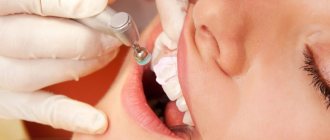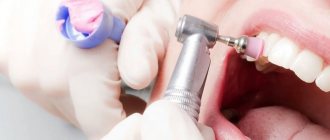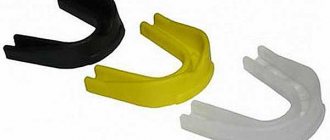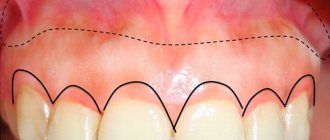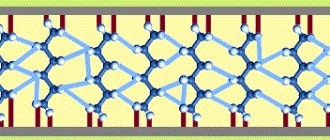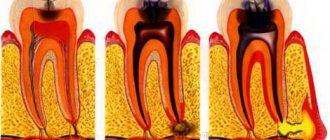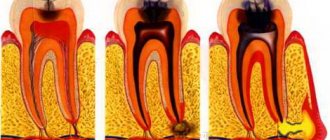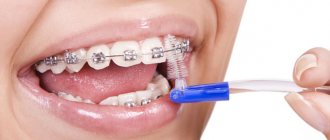Why do you need teeth polishing?
Many patients in dental clinics do not take the procedure seriously and ask the doctor the question of why teeth polishing is needed. Eliminating uneven surfaces of teeth not only makes teeth smooth and gives them a healthy shine. The procedure is carried out to achieve the following goals:
- prevention and removal of soft deposits and tartar;
- smoothing of enamel before starting orthodontic treatment;
- adjustment of the cutter shape;
- removing pigmentation from enamel, evening out its color;
- selection of the material of the desired color before filling.
Thus, both to restore the beauty and health of a smile, polishing and grinding of teeth are periodically carried out - the differences are that the first manipulation involves mechanical leveling of the surface. And the second is to give perfect smoothness. The need for procedures is determined by the dentist.
When is dental restoration necessary?
The most common reasons include:
- Chips and cracks in teeth.
- Incorrect position.
- Destruction of dental tissues.
- Irregular tooth shape or length.
- Change in enamel color.
- Replacing an old filling.
Modern dentistry and the latest technologies make it possible to correct a variety of defects. In addition, by carrying out the restoration procedure with the latest filling material, the tooth is restored to its original appearance and functionality. Today the following materials are used for dental restoration: photopolymers or glass ionomer cement. They can be adjusted to match the natural color of the teeth. Usually the filling looks very natural and does not stand out.
Contraindications to teeth polishing
The benefits of polishing for the health and aesthetics of a smile cannot be overestimated. However, at present there are several contraindications to its implementation:
- gum disease;
- caries;
- increased sensitivity of enamel;
- the occurrence of any inflammation in the oral cavity;
- individual intolerance to at least one of the components of the drug;
- adherence to a salt-free diet for renal failure;
- the presence of certain chronic diseases.
Therefore, before undergoing the procedure, it is necessary to consult a dentist.
Dental instruments for dental treatment
In their practice, dentists use various dental instruments to examine the patient’s oral cavity and treat damaged teeth. Each instrument has its own purpose and is used for the doctor’s most painless manipulations with damaged teeth and gums.
Inspection Instruments
The dentist, after listening to the complaints of the patient who contacted him, must carry out an examination, which consists of a thorough examination of the oral cavity and teeth. A professional dental examination is carried out using diagnostic tools:
— diagnostic mirror – is a round mirror on a long handle and is used to examine areas in the patient’s mouth that are difficult to access and invisible during visual inspection; - probe - looks like a hook with a long handle and is used to determine defects and dental caries, the depth of the carious cavity, its density and sensitivity, as well as the presence of tartar; - tweezers - used by the doctor to determine how loose the tooth is, as well as to place or remove a cotton swab.
Tools for treatment
Treatment of a carious cavity discovered during examination by a dentist consists of several complex stages:
- opening of the cavity; — cleansing and removal of damaged tooth tissues; — filling the cleaned cavity.
Special dental instruments are also used to treat caries:
- dental excavator - is an elongated holder with curved thin ends on both sides, used to remove temporary fillings, food debris and soft damaged tooth tissues; the excavator also removes plaque and deposits on the teeth; - smoothers and spatulas - they are a long holder with spatulas on both sides; they are used to mix filling materials and place them in the open cavity of the tooth; - bur - used to open the cavity and clean it from tissues affected by caries; there are several types of burs for the convenience of cleaning cavities of different shapes, sizes and depths; - disc - used after closing the cavity with a filling to smooth its surface and sharp edges that could remain after treatment with boron; - polisher - the purpose of polishers is the same as that of discs, but they have a different shape. Using the listed tools, the dentist will conduct a preventive and diagnostic examination and save the patient from caries and other dental defects.
Polishing paste
Special polishing pastes contain abrasive particles, with the help of which a leveling effect is achieved. Depending on the size of the abrasive, cleaning compounds are divided into several categories:
- 250 – blue paste with large abrasive particles, used to remove residues of hard plaque and filling material;
- 170 – green composition with medium-sized polishing particles;
- 120 – red fine-grained paste to eliminate minor imperfections;
- 40 – yellow composition with microparticles for treating sensitive areas.
During dental procedures, the doctor first uses a paste with large abrasive particles. And then gradually moves on to treating the tooth surface with fine-grained compounds. During the procedure, pastes are applied to special tools for polishing teeth: drill attachments in the form of rubber cups, cone-shaped brushes, as well as strips (polishing strips).
Tools for polishing the surface of teeth
Polishing the surface of teeth
It is usually performed after removing dental plaque to ensure a smooth surface that prevents plaque retention. Polishing also permanently removes small fragments of mineralized dental plaque and stains on the teeth. The disadvantage of most types of enamel surface polishing is the complete or partial removal of its surface layer, enriched with fluorides. Therefore, it is advisable to treat the polished surface with fluorine-containing solutions.
For polishing, special rotating rubber cups (caps) and end brushes, polishing strips, and flosses can be used.
Soft rubber polishing caps can be completely hollow or with projections (ribs; Fig. 126, A), bridges (Fig. 126, B) or reverse spiral projections on the inner (Fig. 126, B) or outer (Fig. 126, D) surfaces. There are cups with a miniature nylon brush mounted inside (Fig. 126, E). In Fig. 127 different types of polishing cups
(caps).
The caps are fixed in the contra-angle handpiece, filled with polishing paste and polished smooth, sometimes occlusal, surfaces of the teeth at a rotation speed of 2000-5000 rpm (Fig. 128). The cups can be equipped with protective shields to prevent paste from entering the tip head. Cup-to-handpiece fixation systems
can be conventional (for caps equipped with a standard shank for a contra-angle tip, Fig. 129, A) or provide for fixation through special holders (threaded mandrels, Fig. 129, B, or with a disk, Fig. 129, C). Cups can be of different hardness. Thus, soft caps from Densco are blue, medium-hard caps are white, and hard caps are yellow. Edenta's blue superfine preventive polishers can be used without paste at a rotation speed of 5000 rpm, white cups for pastes at 2000 rpm.
For polishing chewing surfaces, it is convenient to use rotating brushes with polishing paste. Brushes can also be used on smooth surfaces that have stains.
To clean the interdental spaces,
thin, flexible, flat-shaped EVA polishing heads
made of wood or plastic are used. When using the EVA system, the interdental spaces are cleaned due to vibrating longitudinal vibrations, which are transmitted to the working part (Fig. 130). Another method for removing plaque from the proximal surfaces of teeth is to use aluminum oxide-coated polishing strips, also used for polishing composite fillings. Flat dental floss or strips of polishing paste, as well as rubber polishing cones for the dental handpiece, can also be used for this purpose.
For cleaning and polishing tooth surfaces, the S.E.T. company proposed the S.E.T.-Prophy-Leader tip - a special tip that provides up-down vertical movement and rotation up to 180° clockwise and counterclockwise (2500 movements per minute; Fig. 132). Special tools (green and brown polishers, brushes) with a curved shank have been developed for the tip.
Stages of the procedure
Treatment of the tooth surface takes place in several stages. Before polishing your teeth, the doctor selects the necessary attachment and abrasive composition. Next, the following manipulations are performed:
- Cleaning flat surfaces and dental cusps. At this stage, blue or green paste is used.
- Carry out polishing using a finely dispersed cleaning composition.
- Mouth rinse.
- Applying fluoride varnish to tooth enamel.
The total duration of the procedure does not exceed 40 minutes. In this case, the patient feels quite comfortable, there is no pain.
The same sequence of actions is maintained when selective tooth polishing is carried out: not everyone knows what it is and when it is necessary. However, the essence of the manipulation is the same, only the surface of the filling or dental crown is polished.
Pastes for removing plaque and polishing tooth surfaces
Pastes for professional oral care are intended for removing non-mineralized dental plaque, immature tartar and pigmented plaque (high- and medium-abrasive pastes), as well as for polishing the tooth surface after removing dental plaque (low-abrasive polishing pastes). The composition of the pastes is close to that of toothpastes for individual use. Professional pastes may be distinguished by higher abrasiveness (usually they are divided by the size of the abrasive filler particles) and the absence of active components, with the exception of mineralizing ones. Pastes may or may not contain fluoride. Fluoride-free pastes can be used to clean teeth before sealing fissures or before filling cavities with composite materials. In these cases, the use of fluoride-containing pastes can disrupt the formation of the microporous structure of the enamel when it is etched with acid. Fluoride-containing polishing pastes usually contain from 1000 to 20,000 ppm of fluoride ions (as part of sodium fluoride, sodium monofluorophosphate or tin fluoride), but their caries-preventive effect has not been definitively proven. Pumice, silicate or zirconium oxide, silicon dioxide are used as abrasive fillers , calcium phosphates.
For ease of use, the paste is placed in a special cup, or a unidose of paste (Fig. 130) is fixed in a special ring on the finger (Fig. 131) or a holder (Fig. 132, A), which is held between the doctor’s fingers (Fig. 132, B) . Treatment with paste is carried out using an end brush, a soft rubber cap (cup), and flat dental floss.
Recommendations after teeth polishing
After performing the above dental procedures, your smile will shine with health and whiteness. To maximize the positive effect, it is recommended to follow several rules:
- for the first 3-4 days, give up colored drinks, such as strong tea, coffee, bright juices;
- during hygiene procedures, do not use active whitening pastes so as not to damage the enamel;
- At first, stop smoking, since tobacco smoke actively destroys the protective layer of enamel and contributes to the accumulation of plaque.
Quite often, after receiving dental services, patients wonder how to restore tooth enamel after grinding and polishing. Because she becomes quite sensitive. The answer is simple - after polishing, dental clinics carry out fluoridation. And brushing your teeth with air flow before polishing will help achieve an even greater effect.
As you can see, polishing is a very useful procedure. If done regularly, your smile will always look great. And most dental diseases will remain a thing of the past forever.
And if you want a flawless smile without polishing, then composite veneers or porcelain veneers are the right option for you.
The doctor's consultation
What types of materials are there for dental restoration?
| Filling material Filtek (USA) | Universal nanocomposite for restoration of anterior and chewing teeth. The most important thing when restoring the front teeth is to choose the right color so that the restored tooth does not differ from the rest. To restore chewing teeth – strength and stability. This material is made not only for fillings, but also for onlays and splinting. |
| Light-curing composite Venus (Germany) | A new filling material, which consists of the smallest nanoparticles, allowing to achieve a high aesthetic effect. Venus composites can be used to recreate the natural shine and color of teeth. This composite is also characterized by high durability and strength, which allows it to be often used when restoring chewing teeth. |
| Photocomposite Enamel Plus (Italy) | When using it, you can achieve the desired tooth shape and achieve 100% natural color thanks to a huge palette of shades. This composite is sometimes called a “chameleon” because over time it is able to adapt to the natural color of the tooth. |
